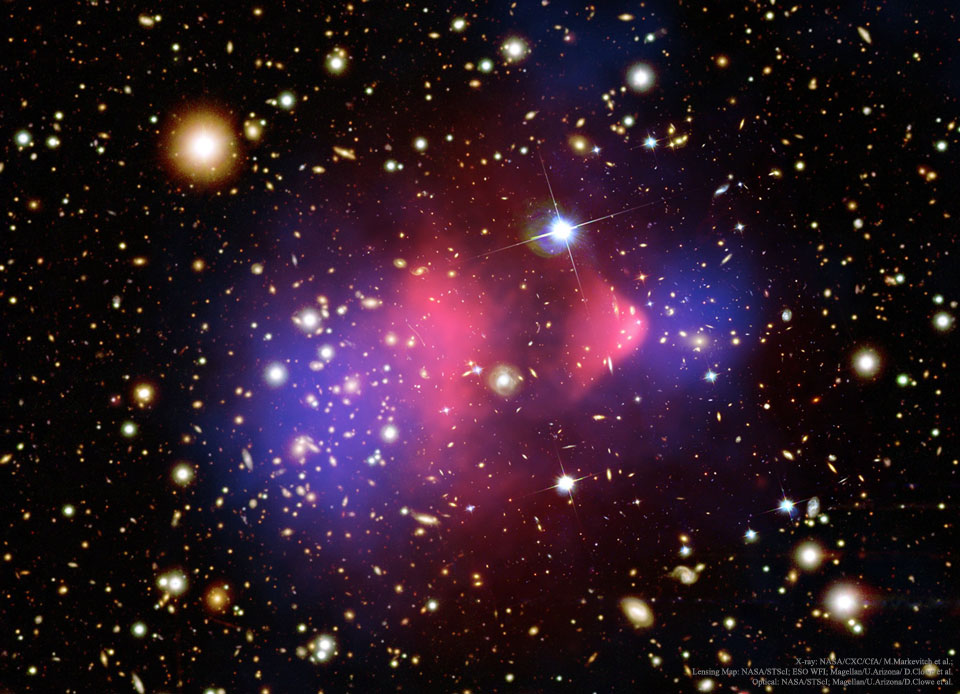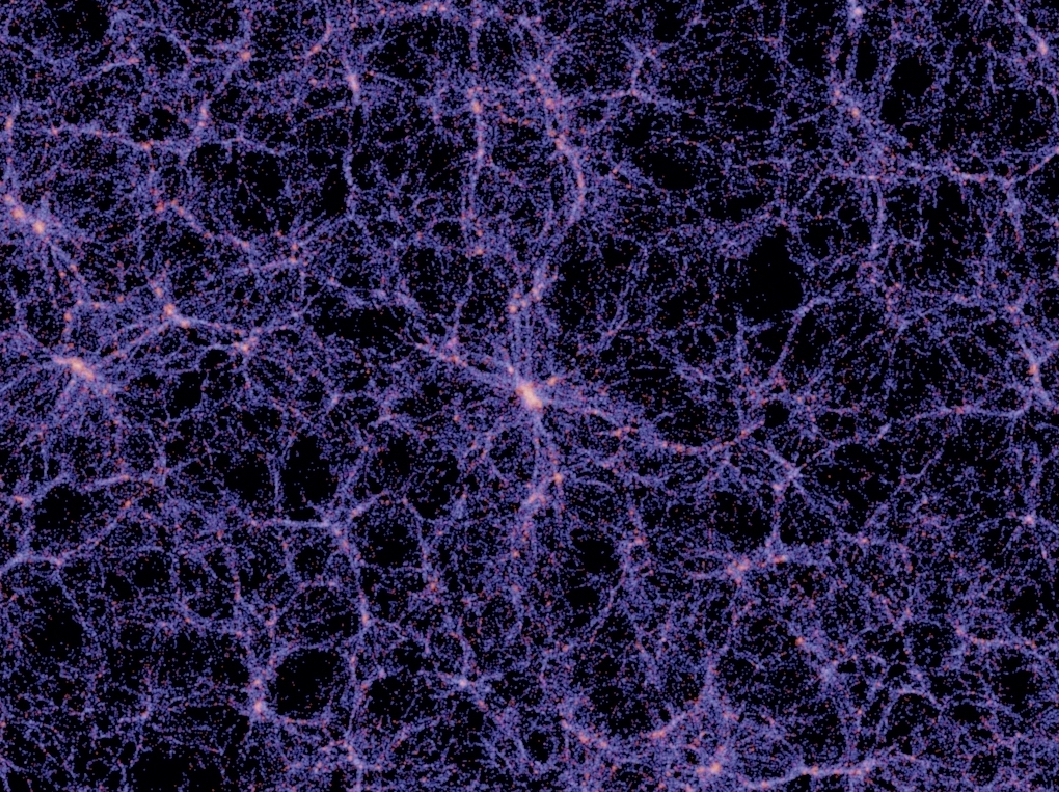Five-sixths of the universe’s stuff seems to be missing, and we just can’t find it. It’s called “dark matter,” and scientists have gone looking for it with some of the world’s largest, most expensive experiments.
Time and time again, these experiments come up empty handed. Most recently, the scientists at the XENON1T experiment, a literal ton of super-sensitive liquid xenon, didn’t find the signal they were looking for after a nine-month search. Nor has the Large Hadron Collider, the world’s largest particle accelerator in Geneva, Switzerland, managed to turn up anything. So, you might wonder, what are we looking for and why? And why are the world’s physicists so deeply divided about what “dark matter” could be?

The XENON1T Time Projection Chamber (TPC) after assembly in a clean room.Photo: XENON1T
Big, strange somethings
As early as the late 19th century, scientific observations were telling us that the universe was more massive than it appeared. Scientists now consider Swiss physicist Fritz Zwicky to be the father of dark matter. Zwicky realised that galaxies in the Coma Cluster seemed to move much too quickly. He thought there should perhaps 400 times more mass in the cluster than he could see, a bit of an overshoot, and called the missing stuff dunkle Materie, or “dark matter.”
Vera Rubin and others’ work in the 1960s and 1970s demonstrated that galaxies themselves must be even larger than the known laws of gravity predicted. Things with mass have gravity, and the more mass they have, the stronger their gravity pulls on things. The laws of gravity predict that in massive, spinning systems (like our solar system or collections of stars), objects at the furthest regions should move more slowly than objects closer to the center, and continue slowing further out.
But these scientists observed that the stars at galaxies’ outer edges don’t slow down — they orbit around the galactic center at around the same speed or even faster than stars nearer to the center. That means the stars were experiencing more gravity, and were in a region with more mass, than expected. Either the laws of physics were wrong, or some strange, darker thing was out there.
Left: What scientists predicted the galaxies “edges” should look like. Right: What scientists now think those “edges” look like, rotating faster than previously predicted, indicating that the “edges” are actually not edges at all, but hidden, extra mass — dark matter.
In fact, all throughout our universe, big things behave as though they are even bigger than they look. And sometimes there’s something where we expect there to be nothing. In the Bullet Cluster of galaxies 3.7 billion light-years from Earth, seemingly empty regions still have enough gravity to bend the light that travels from the galaxies behind it.
But the most significant evidence for dark matter, as University of Chicago physicist Dan Hooper explained at a recent conference, comes from observations of the large-scale structure of the universe itself. It seems to be taking on some sort of gravitational structure for apparently no reason, so something — something thus far undetectable to us — has to be holding it all together. Calculations now imply that there’s around five times more of this dark stuff than regular matter.
There have been, and continue to be, many attempts to understand these strange observations. Some even thought dark matter could be explained by really dim objects, like stars that weren’t emitting light (theoretical things called Massive Compact Halo Objects, or MACHOs). That idea has since been disproved.
A favourite dark matter candidate emerged, not from astronomy, but from particle physics: Weakly Interacting Massive Particles, or WIMPs.

In the Bullet Cluster, light seems to bend in what should be empty space. Researchers now believe those areas contain dark matter.Image: X-ray: NASA/CXC/CfA/ M. Markevitch et al.; Lensing Map: NASA/STScI; ESO WFI; Magellan/U.Arizona/ D.Clowe et al. Optical: NASA/STScI; Magellan/U.Arizona/D.Clowe et al.
The most widely accepted hypothesis is that dark matter is composed of WIMPs — fundamental subatomic particles that are too weak for us to notice here on our regular-matter Earth, like a breeze too light to nudge a brick house.
Since the turn of the millennium, scientists believed these particles would be discovered any day now. But that’s no longer the case. Because WIMPs have not been yet discovered, physicists are split over dark matter: Is it WIMPs or is it something stranger?
“At least 15 years ago, when people had conversations about dark matter, they used the words ‘dark matter’ and ‘WIMPs’ interchangeably,” Hooper told Gizmodo. “There’s been a gradual but significant shift… No one is doing that stuff anymore. People now have a broader, global idea of what dark matter is made of.”
The miracle
With 2012’s discovery of the Higgs boson, particle physicists thought they had identified all of the particles that make up the universe and all of the forces between them, completing the Standard Model. It’s a consistent theory, but it’s got holes. It’s like a mostly mapped cave in which there are a few mysterious areas remaining, from which strange, unexplained winds blow.
One such mysterious region contains the potential for a new realm of undiscovered particles — a realm where there is an evil twin for every existing particle. These theorised mirrorworld particles, called “superpartners,” are more massive than the standard set. Physicists have wondered about this “supersymmetry” for decades — it could potentially answer some of the most important outstanding questions about the Standard Model, like why gravity is so extremely weak compared to the other forces, especially the “weak nuclear force” that governs certain behaviours between subatomic particles.
Despite their separate origins, dark matter and supersymmetry aligned in the 1990s. This coincidence is called the “WIMP” miracle — when physicists realised that if supersymmetric particles existed, they could be the WIMPs that explain the extra mass ascribed to dark matter. “Of the many WIMP candidates, perhaps the best motivated and certainly the most theoretically developed is the neutralino, the lightest superpartner in many supersymmetric theories,” a 1996 report read. In other words, superpartners would make great WIMPs.
The hunt for WIMPs has travelled two separate paths. One approach uses the Large Hadron Collider to slam together protons (sub-atomic particles), in hopes of finding some anomaly in the resulting collision, a sign of a previously undiscovered particle that could be dark matter. As of yet, LHC physicists have not found any such particle. But they aren’t done searching, and they aren’t giving up any time soon.
Several experiments take a second approach. If five-sixths of the universe is potentially made of WIMPs, some of these particles must be hitting the Earth. From Canada to South Korea, these experiments are trying to detect WIMPs from space with super-sensitive detectors buried deep underground in isolated chambers to stop any extra particles, like cosmic rays, from interfering with the setup. The idea is that a dark matter particle would interact ever-so-slightly with the detector’s material. The most sensitive experiment yet, XENON1T, is located under a mountain in Italy and uses one ton of cryogenic liquid xenon as a detection material. It has yet to find anything in its nine-month search at its current mass, or in 10 years of its previous iterations. Or rather, it’s found a lot of nothing — properties that dark matter can’t have, giving us some idea of what properties dark matter could potentially have. It’s like sketching a silhouette by shading in the empty space. So far, scientists have ruled out the idea of what’s known as “the vanilla WIMP,” or the most basic, most mathematically obvious idea of what a WIMP could be, agreeing that the real WIMP is probably a lot stranger and less predictable.
Though WIMPs haven’t yet been discovered, the theory isn’t dead. Most of the folks in the WIMP-searching field feel that the WIMP is still out there, waiting to be discovered. Still, people are getting antsy.
Where the wild WIMPs are (and aren’t)
This past spring, physicists have met at the Kavli Institute for Theoretical Physics in Santa Barbara, California and the Moriond Conferences in Italy to discuss the state of the dark matter search. It’s becoming clear that many are seeking new avenues to solve the mystery.
“We’ve all been hoping and kinda thinking we’d find some signal in the standard searches,” James Beacham, post-doctoral researcher with CERN’s ATLAS experiment at the Ohio State University, told Gizmodo. “Since we keep coming up empty, it’s forcing people to think in wildly different ways.”
For example, perhaps there’s another particle, a strongly interacting massive particle, or SIMP, that could be found if only the detectors weren’t so deep underground. Others have rallied around the axion, another subatomic particle that would simultaneously explain the missing dark matter and solve a separate problem in particle physics regarding the force that holds atomic nuclei together. Others think perhaps there are primordial black holes left over from the Big Bang that haven’t been found yet.
XENON physicists agree that these alternative ideas are important.
“There’s still a lot of parameter space for WIMPs, but at the same time we have to explore other possibilities as well,” Laura Baudis, University of Zurich physicist who works on the XENON collaboration, told Gizmodo.
And the continuing lack of detection has led to an influx of younger physicists pursuing more exotic solutions to the problem, said Jonathan Feng, professor of physics and astronomy at the University of California Irvine.
But still others wonder whether or not we’ve just gotten something fundamentally wrong about the laws of physics in general. What if dark matter is just our generation’s luminiferous ether? Scientists once thought that in order to travel as a wave, light must travel through some medium — the “ether.” This was proven wrong by experiments from Albert Michelson and Edward Morley and laid to rest by Albert Einstein’s theory of general relativity. Perhaps what we call “dark matter” can be explained away with a new theory that doesn’t require finding some strange kind of mass.
One such class of theories is Modified Newtonian Dynamics, or MOND. It posits that maybe Isaac Newton’s laws of gravity need a tweak to account for the behaviour extremely large, slow things, such as the very slowly accelerating edges of galaxies, explained Stacy McGaugh, astronomer at Case Western Reserve University. McGaugh once told Gizmodo that dark matter was “a tooth fairy that we invoked early on to make things work out.” Whenever a part of the universe appeared to not obey the laws of physics, scientists would use dark matter to explain away those discrepancies, to fill in the gaps. Perhaps those parts of the universe don’t need dark matter to obey the laws of physics after all, because they simply don’t obey the laws as we understand them in the first place.
Maybe, thinks McGaugh, dark matter represents an incompleteness of the most famous law that governs gravity: the theory of general relativity. “Right now the general attitude is that general relativity was given to us by a God and can’t be questioned, therefore dark matter must exist,” he said. “I worry that we deify Einstein too much.”
Or maybe we misunderstand the origin of gravity itself. Maybe gravity actually emerges out of the mathematics of quantum mechanics, the physics of the smallest things, the same way that temperature emerges out of the motion of particles, said Erik Verlinde, theoretical physicist at the University of Amsterdam. We currently think about gravity in the sense of mass interacting with space itself, but maybe gravity is a result of collective behaviour of particles. Then, perhaps, dark matter is result of that collective behaviour, and not of the existing theory of general relativity.
“People say [dark matter] has to be a particle. For me, those arguments don’t make sense. We haven’t thought about the other possibilities for what it can be,” Verlinde told Gizmodo. “In a sense, dark matter is a placeholder for a thing we don’t understand yet.”
The search continues
There are many reasons why dark matter could be something other than WIMPs. We might be misunderstanding the laws of physics; those laws might not apply to dark matter; or those laws might be wrong or incomplete. But scientists have already invested a lot of time and money in the search for WIMP dark matter.
Even with the most recent results in which scientists found nothing, there are a lot of different WIMP possibilities left. But current and future experiments are limited by the neutrino floor — the point at which the experiments become so sensitive that a dark matter particle would be indistinguishable from another weakly interactive particle physicists have already observed, called the neutrino.
But there are still more possible kinds of WIMPs that haven’t been ruled out before the experiments reach the neutrino floor, and the search must continue. “We haven’t explored the whole region,” said Elena Aprile, the XENON collaboration’s spokesperson and Columbia University Experimental Particle Physicist. “And it’s impressive what we’ve been able to do. Finding nothing is very important. You have to find nothing.” You can’t tell where the particles are until you’ve determined where the particles can’t be.

The cosmic web, the largest model of what our universe looks like, forming a gravitational structure that could be held together by dark matter.Image: Wikimedia
The U.S. Natural Science Foundation plans to fund experiments that will hunt particles all the way to the neutrino floor. It has already decided to fund WIMP-hunting experiment Super-CDMS, and is also funding the under-construction LZ, which will contain 10 tons of liquid xenon. XENON1T will upgrade to XENON-nT. And perhaps one day, an experiment called DARWIN will finish the job.
Have no fear of waste: All these experiments can measure things aside from dark matter, should a WIMP go undiscovered. They can become supernovae observatories or perform other particle physics measurements.
Even in the face of a non-detection, tantalising hints from space continue to whet scientists’ appetite for a dark matter particle. China’s appeared to be altered by some dark matter particle in the early universe.
And yet, the WIMPs are losing power as the reigning theory. The longer physicists go without a detection, the more new ideas to explain dark matter will emerge.
Will we find WIMPs? “There’s no way of telling,” said Baudis. But scientists will continue doing science. “Whatever we think, nature doesn’t care about it at all. One way or another, we have to keep looking.”
